Master Brand to Conquer Asian Markets
BUSINESS TIPS
River Chan
8/20/202410 min read

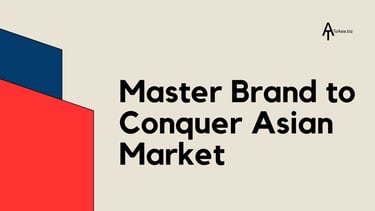
Navigating the complex landscape of Asian markets can feel like traversing a labyrinth blindfolded.
But fear not – this guide is your beacon of light, illuminating the path to brand success in the East.
Asia isn't just a market; it's a mosaic of cultures, each with its own set of unwritten rules and expectations.
The brand that thrives in Seoul could struggle in Mumbai.
Many western brands fail to gain traction in Asia within their first year.
Why? Because they treat Asia as a monolith, failing to recognize its rich diversity.
But here's the silver lining: brands that crack the code see an average revenue growth in Asian markets.
The secret?
It tailored branding strategies that resonate deeply with local audiences.
Consider this:
Asian consumers prefer brands that understand their cultural nuances.
Customers are more likely to purchase from brands that collaborate with local influencers.
Audiences value brands that adapt their messaging to local languages and dialects.
The stakes are high, but so are the rewards.
Asia represents 60% of the global population and is home to some of the world's fastest-growing economies.
Ignoring the nuances of Asian markets isn't just a missed opportunity – it's a recipe for brand irrelevance in the 21st century.
This guide will arm you with the insights, strategies, and tactical approaches to not just survive, but thrive in Asian markets.
From defining your brand identity to leveraging local ambassadors and mastering region-specific marketing techniques, we've got you covered.
Conclusion: Mastering the Art of Branding in Asia
As we've explored, building a powerful brand in Asia goes far beyond logos and slogans.
It's about crafting a holistic identity that resonates deeply with diverse cultures, leveraging authentic ambassadors, and implementing marketing strategies that create lasting emotional connections.
Key takeaways:
Your brand is the sum of every interaction, not just visual elements
Adapt your identity to local contexts while maintaining global consistency
Choose brand ambassadors who truly embody your values and understand local nuances
Engineer cultural relevance through storytelling and community engagement
Measure your impact rigorously, adjusting strategies based on data-driven insights
In Asia's dynamic markets, success comes to brands that are flexible yet authentic, global yet locally attuned, innovative yet respectful of traditions.
The path to brand mastery in Asia is challenging, but the rewards are immense.
By understanding the deeper currents of brand identity, leveraging the power of human connections through brand ambassadors, and implementing culturally resonant marketing strategies, you're not just building a brand – you're creating a lasting legacy in one of the world's most exciting and diverse regions.
Your brand's journey in Asia is just beginning.
Embrace the complexity, celebrate the diversity, and watch your brand not just enter Asian markets, but become an integral part of them.
Ready to turn these insights into action?
ToAsia.biz is your trusted partner in navigating the complex landscape of Asian markets.
Our team of growth experts combines deep local knowledge with global best practices to help your brand thrive across Asia.
From crafting culturally resonant brand identities to connecting you with the right brand ambassadors and implementing cutting-edge marketing strategies for Asian market success.
Don't just enter Asian markets – dominate them.
Contact us to schedule a free consultation.
Let's build your brand's Asian success story together!


Understanding Brand Beyond the Logo
Let's shatter a myth right now: Your brand isn't your logo. It's not even close.
Think of your logo as the tip of an iceberg.
It's what people see first, sure. But 90% of your brand?
That's lurking beneath the surface, invisible but incredibly powerful.
So what is a brand, really?
"It's the gut feeling people get when they hear your name."
Did you know?
95% of purchasing decisions are subconscious.
Your brand is that subconscious trigger.
"It's the stories your customers tell their friends."
Word-of-mouth drives $6 trillion of annual consumer spending.
"It's the consistency of your product or service."
Over 70% of consumers say consistency is key to brand loyalty.
"It's the values you stand for (and stand by)."
Over 70% of consumers prefer buying from companies aligned with their values.
"It's the problems you solve and how you solve them."
Over 70% of consumers buy from brands that share how they're making the world better.
"It's the experience at every touchpoint—from first ad to final invoice."
86% of buyers are willing to pay more for a great customer experience.
Here's a litmus test for you:
Next time someone says, "We need to rebrand,"
ask them this:
What exactly are we trying to change about how our customers perceive and experience us?
If the answer is "nothing," you don't need a rebrand. You need a new logo.
If the answer is "everything," you don't need a new logo. You need a new business.
But if the answer is somewhere in between? That's where the real work begins.
Building a strong brand isn't about perfecting your visuals.
It's about aligning every aspect of your business with the promise you make to your customers.
And delivering on that promise. Every. Single. Time.
Action Steps:
Audit your brand: Does every touchpoint reflect your brand promise?
Survey your customers: What stories are they telling about you?
Align your team: Does everyone understand your brand beyond the logo?
A logo change is easy.
A true rebrand? That's where the magic happens.
That's how you build a brand that stands out.
That's how you build a brand that lasts.
In Asia, where brand loyalty can be fleeting and competition fierce, this understanding isn't just important—it's survival.
Next time you think about your brand in Asian markets, look beyond the surface.
Dive deep. That's where the real brand lives.
That's where you'll find the key to lasting success in this dynamic region.


Your Brand Identity Checklist
✓ Is your logo recognizable at any size, from billboard to app icon?
✓ Do your colors evoke the right emotions in different Asian cultures?
✓ Is your typography legible in multiple languages?
✓ Does your messaging resonate with local values while maintaining global appeal?
✓ Can your brand identity flex across various platforms without losing its essence?
✓ Have you considered local cultural nuances in each market you're entering?
In Asia, your brand identity isn't just about standing out.
It's about fitting in while standing out.
It's a delicate balance of global appeal and local resonance.
Your brand identity is your promise made visible.
In the diverse and dynamic Asian market, make sure it's a promise that translates, adapts, and resonates across cultures.
That's how you build a brand that doesn't just enter Asian markets – it becomes a part of them.
This comprehensive view of brand identity allows you to create deeper connections with Asian consumers, fostering loyalty and driving long-term success.
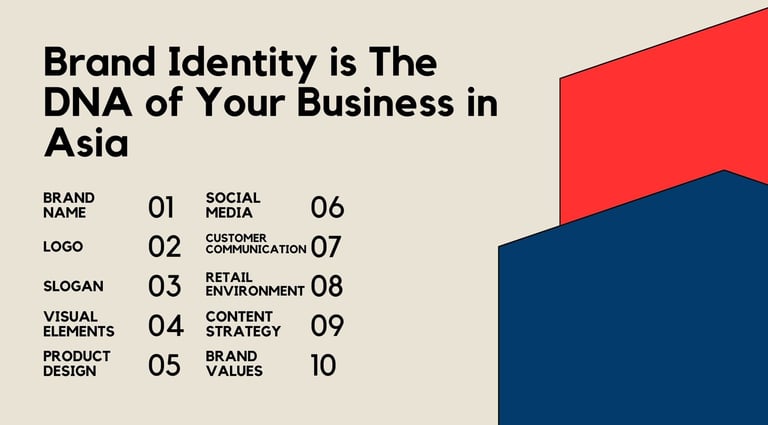

Brand Identity is The DNA of Your Business in Asia
In the vibrant tapestry of Asian markets, your brand identity is your genetic code.
It's what makes you instantly recognizable, memorable, and uniquely you.
Components of Brand Identity:
Brand Name: Your verbal signature
Consumers make purchases based on a brand name.
Example: Alibaba, meaning "Open Sesame" in Arabic, resonates with the idea of unlocking opportunitiesLogo: A visual cue, but not the whole story
Consumers recognize a brand by its logo, it's just one piece of the puzzle.
Example: Singapore Airlines' logo of a flying crane symbolizes grace and Asian hospitalitySlogan: Your brand promise in a nutshell
Consumers are more likely to remember a brand's slogan than its logo.
Asian twist: Pocari Sweat's "Ion Supply" slogan in Japan perfectly describes its functionVisual Elements: Your brand's aesthetic language includes colors, typography, imagery, and design patterns
It is a snap judgment about products based on color alone.
Example: Uniqlo's simple, clean aesthetic reflects its philosophy of high-quality basicsProduct Design: Your brand in 3D
It is a first impression that is design-related.Social Media Presence: Your brand in the digital realm
Asian consumers discover new brands through social platforms to ensure consistent brand voice and visual style across all social channels.Customer Communication: Your brand's personality in action
Most of the customers say customer service is important in their choice of loyalty to a brand.Retail Environment: Your brand's physical embodiment
Asian shoppers still prefer in-store experiences for certain categories.
Success story: Muji's minimalist store designs perfectly reflect its "no-brand quality goods" philosophyContent Strategy: Your brand's thought leadership
Consumers feel closer to a company as a result of content marketing e.g. Tailor content to local interests and trends in each Asian marketBrand Values: The invisible force driving your brand
Consumers prefer buying from companies aligned with their values
Example: Patagonia's commitment to sustainability resonates strongly with eco-conscious Asian millennials
Your brand identity is a multifaceted entity that goes far beyond just a logo or visual elements.
It's the sum total of how your brand looks, sounds, acts, and feels across all touchpoints.


Brand Ambassador is Your Human Face in Asian Markets
In the relationship-driven cultures of Asia, brand ambassadors are more than just spokespersons – they're the living, breathing embodiment of your brand.
A brand ambassador is anyone who represents and promotes your brand positively. They can be:
Employees (Internal ambassadors)
Influencers (External ambassadors)
Loyal customers (Organic ambassadors)
Over 90% of consumers trust recommendations from individuals (even if they don't know them) over brands.
Internal Brand Advocacy:
Your employees are your most powerful brand advocates. Why?
Consumers view employee posts as more credible than corporate accounts, especially on LinkedIn.
Employee advocacy programs can increase revenue by up to 26%.
Invest in your internal brand ambassadors. They're your front-line brand representatives.
Influencer Engagement:
In Asia, influencer marketing isn't just trendy – it's essential.
Asian consumers trust influencer recommendations.
70% of Asian consumers prefer influencers who speak their local language.
Local influencers understand cultural nuances that global celebrities might miss.
Harnessing the Power of Word-of-Mouth:
Your loyal customers are your most authentic and cost-effective brand advocates.
They spend more than new customers and customer referrals have a higher retention rate compared to other acquisition channels.
Encourage and incentivize your loyal customers to share their positive experiences.
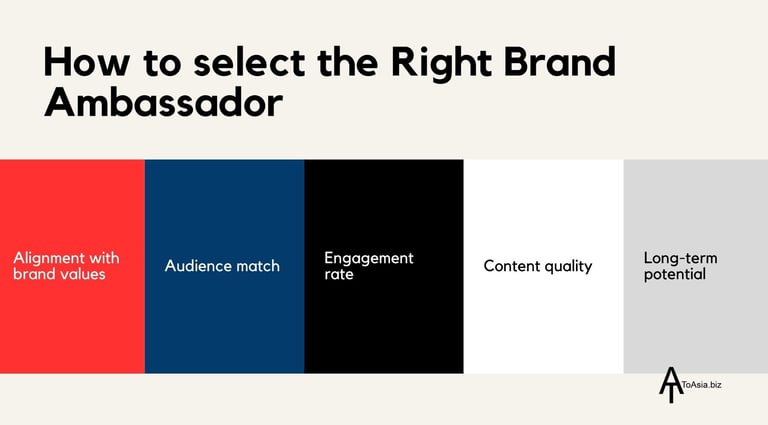

How to select the Right Brand Ambassador
Alignment with brand values
83% of consumers say authenticity is important when choosing brandsAudience match
Does their follower demographic match your target market?Engagement rate
Look for influencers with high engagement, not just high follower countsContent quality
Their content should align with your brand aestheticsLong-term potential
Can they grow with your brand?
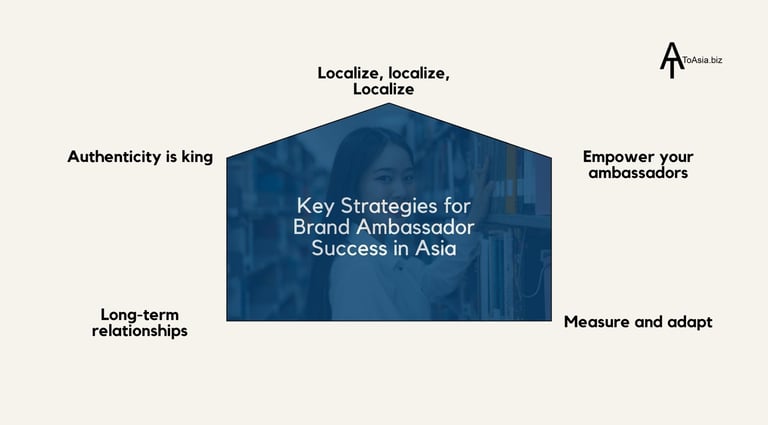

Key Strategies for Brand Ambassador Success in Asia
Localize, localize, localize
Consumers prefer buying products with information in their local language and local culture which is localizationAuthenticity is king
Consumers say authenticity is important when deciding which brands they like and supportLong-term relationships > one-off campaigns
Brands that maintain long-term influencer relationships see 3x higher engagement ratesEmpower your ambassadors
Give them creative freedom within brand guidelinesMeasure and adapt
Regularly assess ROI and be ready to pivot strategies
Action Steps:
Audit your current brand ambassador strategy. Is it truly resonating in each Asian market?
Invest in employee advocacy programs. Your team is your best asset.
Consider a mix of micro and macro-influencers for a balanced approach.
Always, always prioritize cultural sensitivity and local relevance.
In Asia, your brand ambassador isn't just promoting a product – they're building relationships.
Choose wisely, train thoroughly, and let authenticity lead the way.
Your brand ambassadors are the bridge between your brand and Asian consumers.
Make sure it's a bridge built on trust, authenticity, and cultural understanding.
That's how you turn curious onlookers into loyal brand advocates in the diverse and dynamic Asian marketplace.


Brand Marketing is Engineering Cultural Resonance in Asia
In the dynamic tapestry of Asian markets, brand marketing in Asia is the art of cultural engineering.
It's about creating emotional bridges between your brand and local values, aspirations, and traditions.
Emotional connections can increase customer lifetime value and consumers cite shared values as the primary reason for brand relationships.
Don't just sell products.
Sell experiences that resonate with Asia cultural diversity.
So what are the brand strategies for success?
Storytelling: The Heart of Asian Brand Marketing
In cultures steeped in oral traditions, storytelling is your secret weapon.
Consumers want brands to make ads that feel like a story and stories are 22 times more memorable than facts alone.Community Engagement: Building Brand Ecosystems
In collective societies, community engagement is crucial.
Asian consumers are more likely to trust a brand that actively engages with its community.Digital Marketing: Navigating the Asian Internet Landscape
Asia leads the world in digital adoption.
Your brand needs to be where the consumers are like Threads, Tiktok, LINE etc.
Tailor your digital strategy to local platforms and user behaviors.
One size does not fit all in Asian markets.
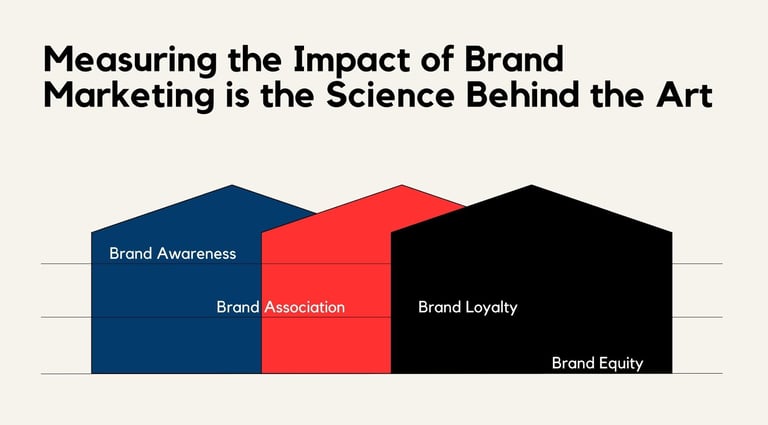

Measuring the Impact of Brand Marketing is the Science Behind the Art
In the data-driven Asian market, measuring brand equity isn't optional—it's essential.
Key Metrics to Track:
Brand Awareness: Are you top-of-mind in your category?
Brand Association: What values do consumers link to your brand?
Brand Loyalty: Are customers coming back?
Brand Equity: How does your brand value compare to competitors?
Tools for Measurement:
Social Listening: Monitor brand mentions and sentiment
Customer Surveys: Direct feedback on brand perception
Sales Data: Ultimate indicator of brand performance
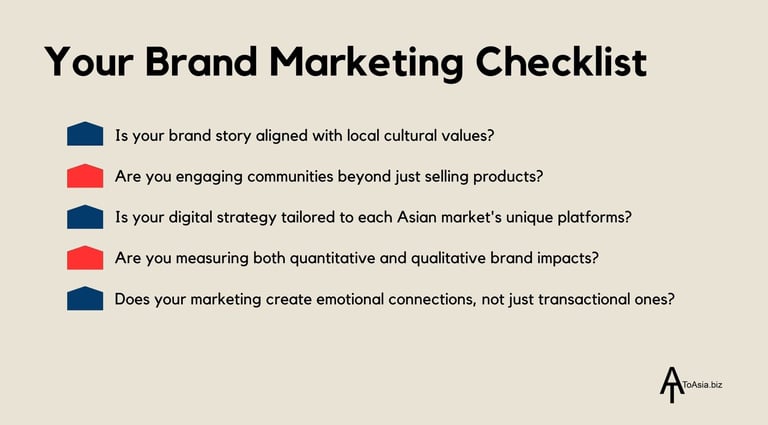

Your Brand Marketing Checklist for Asia
✓ Is your brand story aligned with local cultural values?
✓ Are you engaging communities beyond just selling products?
✓ Is your digital strategy tailored to each Asian market's unique platforms?
✓ Are you measuring both quantitative and qualitative brand impacts?
✓ Does your marketing create emotional connections, not just transactional ones?
In Asia, brand marketing is a delicate balance of art and science.
It's about creating cultural resonance while driving measurable business results.
Your brand isn't just competing for market share—it's vying for a place in the hearts and minds of Asian consumers.
By engineering cultural connections, crafting compelling stories, fostering communities, mastering local digital landscapes, and rigorously measuring your impact, you're not just marketing a brand.
You're creating a cultural phenomenon.
In the vibrant, diverse, and fast-paced Asian marketplace, that's how you build a brand that doesn't just succeed—it thrives.


River Chan is a marketing director of ToAsia.biz with over 10 years of experience in marketing from strategic planning, project execution, and data analysis across different industries.
About Author
Copyright © 2025 ToAsia.biz


We lead your business to Asia
Our Business Growth Experts help SaaS businesses achieve growth in Asia and become profitable FAST.
Send us a message via WhatsApp
